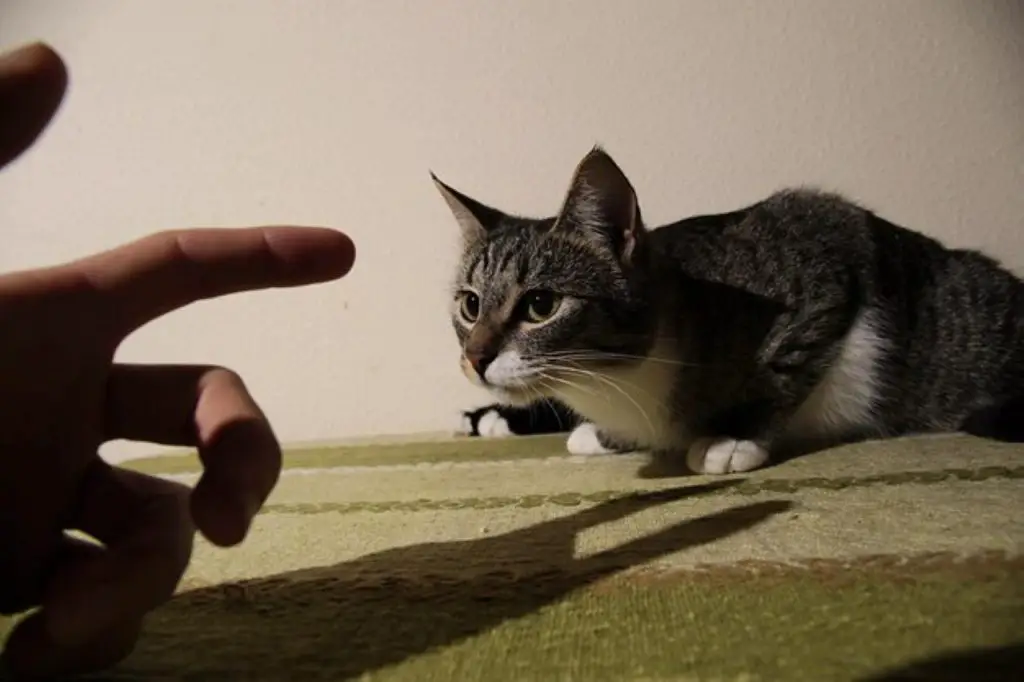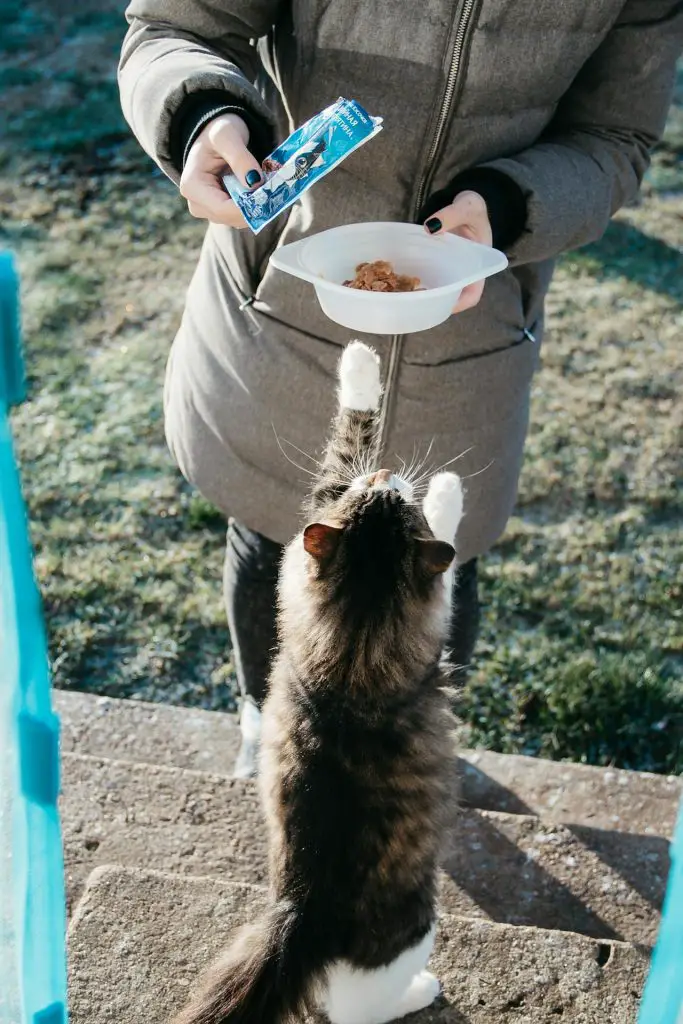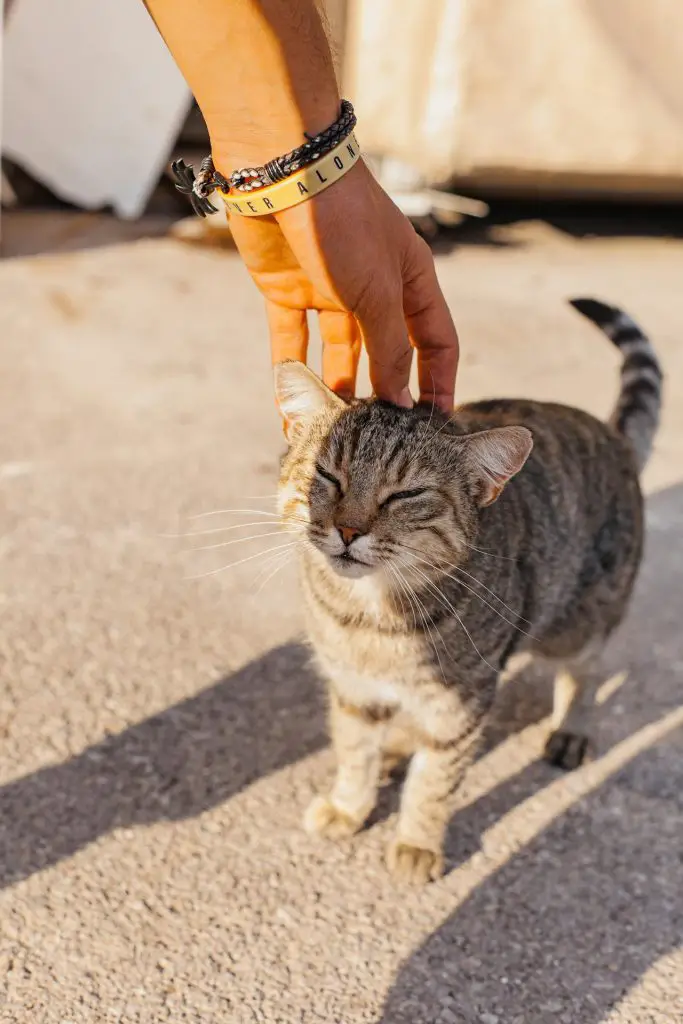You can train a stray cat by establishing a foundation of trust through a consistent feeding routine and gradual exposure to your presence. Start by letting the cat set the pace for interaction and feeding, then gradually increase your presence during meal times. Create a safe environment by providing a quiet, sheltered space with warm bedding and toys.

As you build trust, you can begin using positive reinforcement techniques to teach basic commands and manage any aggression issues. With patience and the right approach, you’ll be well on your way to helping your stray cat become a loving companion.
Table of Contents
Building Trust With Food
By establishing a consistent feeding routine, you’ll initiate a foundation of trust with the stray cat, allowing it to gradually associate your presence with a reliable source of nourishment.
As you begin to build trust, observe the cat’s food preferences to understand what it likes and dislikes. You may need to try different types of food, such as wet or dry, to determine its favorite. Once you’ve found a food that works, stick to it.
Gradual exposure to your presence during meal times is essential. Start by placing food near the cat, allowing it to eat without direct interaction.
This post contains affiliate links. However all the information provided on this site are my own honest opinions. See more in Disclaimer.
As the days go by, slowly increase your presence, sitting near the cat while it eats. Eventually, you’ll be able to feed it by hand, further strengthening your bond.
Consistency and patience are vital. Stick to your routine and let the cat set the pace. With time and effort, the stray cat will come to trust and rely on you for sustenance, paving the way for further training and interaction.
Creating a Safe Environment
Once trust has been established through a consistent feeding routine, you’ll need to provide the stray cat with a safe and sheltered space where it can feel secure and relaxed.
This is essential for creating a sense of belonging and reducing stress.
Start by designating a quiet area of your home as a safe zone, free from noise and distractions. Add some warm bedding, such as a towel or blanket, to make the space cozy and inviting.
To promote environmental enrichment, add some toys, scratching posts, and climbing structures to the safe zone. This will stimulate the cat’s natural hunting instincts and provide exercise.
You can also rotate the toys regularly to keep things interesting.
Make sure the safe zone is easily accessible and preferably has a view of the surrounding area, allowing the cat to observe its environment without feeling overwhelmed.
Establishing a Routine
To help the stray cat feel more secure and develop a sense of familiarity, you’ll need to establish a daily routine that includes regular times for feeding, play, and sleep.
Consistency is key when creating a routine, as it allows the cat to anticipate what’s happening next and feel more in control.
Start by setting a schedule for daily activities, such as feeding times, play sessions, and sleep periods. Stick to this routine as closely as possible, even on weekends or days off, to maintain a sense of stability.
A consistent routine also helps you identify any changes in the cat’s behavior or appetite, which can be an indicator of underlying health issues.
By establishing a daily routine, you’ll be able to provide the cat with a sense of security and structure, which is vital for building trust and facilitating the training process.
Positive Reinforcement Techniques

Positive reinforcement techniques, such as clicker training and reward-based interactions, play an essential role in helping you build trust and encourage desired behaviors in the stray cat.
By focusing on positive associations, you create a safe and supportive environment that fosters a strong bond between you and the cat.
With clicker training, you can teach the cat to associate the sound of a clicker with a reward, such as treats or affection.
To effectively use positive reinforcement techniques, consider the following:
- Start with short training sessions to avoid overwhelming the cat.
- Use high-value rewards to motivate the cat and encourage desired behaviors.
- Be consistent in your interactions and use the same commands and rewards.
- Use clicker training to teach specific behaviors, such as sitting or coming when called.
Handling and Socialization
As the stray cat becomes more comfortable with your presence, handling and socialization techniques can help you build a stronger bond and prepare the cat for a life in a domestic environment.
You can start by gently petting the cat, beginning with areas they enjoy, such as the head or behind the ears. Gradually increase touch and handling to help them become confident in your presence.
Introduce grooming techniques, like brushing or nail trimming, to help the cat relax and become accustomed to touch. This will also allow you to inspect their coat and health.
Socialization activities, such as playtime with toys or interactive games, can help the cat develop trust and build a connection with you.
Encourage the cat to explore new environments and interact with different people to broaden their social skills.
Training Basic Commands

Now that you’ve made progress with handling and socialization, it’s time to teach your stray cat basic commands.
To do this, you’ll need to establish trust slowly, using positive reinforcement techniques that encourage good behavior.
Establishing Trust Slowly
When working with a stray cat, establishing trust slowly is essential. The best way to begin this process is by teaching basic commands that help the cat associate your presence with a positive outcome.
A slow approach and gradual interaction will allow the cat to become comfortable with your presence, reducing stress and anxiety.
To establish trust slowly, consider the following tips:
- Start by spending quiet time near the cat, allowing it to become accustomed to your presence.
- Move at the cat’s pace, and never force interaction if the cat isn’t ready.
- Use a calm and gentle tone of voice to reassure the cat.
- Let the cat initiate contact, and respect its boundaries if it doesn’t want to interact.
Positive Reinforcement Techniques
Your stray cat’s training relies heavily on positive reinforcement techniques, which focus on rewarding desired behaviors rather than punishing undesired ones, to teach basic commands and strengthen the bond between you and the cat.
This approach encourages good behavior, making it a powerful tool for shaping your cat’s actions.
Trending in Cats:
One effective method is clicker training, where you associate a distinct sound with a reward to mark desired behaviors.
Start by introducing the clicker sound when feeding your cat treats, allowing them to associate the noise with a positive outcome.
Scent association is another valuable technique. Cats have a strong sense of smell, and by linking a specific scent to a reward, you can prompt desired behaviors.
For example, use a specific toy or cloth with a familiar scent to encourage your cat to come when called.
Consistency is key when using positive reinforcement techniques. Set clear goals and rewards, and be patient with your cat as they learn.
Rewarding Good Behavior
How do you effectively reward good behavior in your stray cat, turning simple actions into reliable commands that strengthen your bond and establish a framework for more complex training to come?
Rewarding good behavior is essential in shaping your cat’s actions and building trust. By associating desired behavior with positive outcomes, you’ll encourage your cat to repeat those actions.
To reward good behavior, use treat rewards strategically. Here are some tips:
- Use small, tasty treats that your cat loves.
- Reward your cat immediately after they perform the desired action.
- Be consistent in your rewards to avoid confusing your cat.
- Gradually phase out treats as the behavior becomes habitual.
Addressing Feral Behavior
As you work with your stray cat, it’s crucial to address any feral behavior that may be present.
You’ll need to understand the cat’s body language, taking note of postures and vocalizations that signal fear, aggression, or defensiveness.
Understanding Feral Body Language
Recognizing feral body language is essential in addressing feral behavior, since subtle cues, such as a twitching ear or tail, can signal aggression, fear, or anxiety in a stray cat.
By understanding cat communication, you can better navigate interactions with the stray cat and avoid triggering a defensive response.
Feral cats often exhibit distinct body signals that can help you gauge their mood and intentions.
Here are key body language cues to watch for:
- Ears forward and perked up: Confidence and friendliness
- Tail held high: Alertness and assertiveness
- Direct stare: Dominance or aggression
- Averted gaze: Submission or fear
Building Trust Slowly

Establishing trust with a stray cat requires a gradual, calculated approach that allows the cat to dictate the pace of interaction, helping you earn its confidence without triggering a fearful or aggressive response.
You’ll need to employ patience techniques, letting the cat become comfortable with your presence before attempting any physical interaction.
Begin by sitting quietly in the same room as the cat, allowing it to become accustomed to your scent and energy.
Gradual exposure is key, so start with short sessions and gradually increase the duration.

As the cat becomes more relaxed, you can introduce gentle, soothing sounds, such as soft speaking or calm music.
Reward the cat with treats and affection when it exhibits calm behavior, but avoid sudden movements or loud noises.
As trust builds, the cat will begin to initiate interactions, such as approaching you or rubbing against your leg. This is a significant milestone, and you can now start to introduce gentle touch, such as light petting or stroking.
Managing Aggression Issues
Many stray cats exhibit feral behavior, including hissing, growling, or swatting, which requires your careful attention and strategic management to guarantee a safe and successful interaction.
To manage aggression issues, you’ll need to employ de-escalation techniques and understand what triggers these behaviors in the first place.
Start by maintaining a safe distance and speaking in a calm, gentle voice to reassure the cat that you mean no harm.
Identify and avoid triggers such as loud noises or sudden movements that can cause the cat to become agitated.
Watch for body language cues, such as flattened ears or tail swishing, which can indicate agitation or fear.
Use positive reinforcement techniques, such as treats and praise, to encourage calm behavior.
Gradually increase interaction time, starting with short sessions and gradually increasing the duration as the cat becomes more comfortable with your presence.
Overcoming Fear and Aggression

To overcome a stray cat’s fear and aggression, you must approach the animal calmly and carefully, allowing it to become comfortable with your presence at its own pace.
Start by identifying the cat’s fear triggers, such as loud noises, sudden movements, or specific objects. Once you’re aware of these triggers, you can take steps to avoid or minimize them, creating a more relaxed environment for the cat.
As you interact with the cat, watch for aggression signs like hissing, growling, or flattening ears. If you notice any of these behaviors, back off immediately and give the cat space.
Gradually build trust by offering treats, starting from a safe distance. As the cat becomes more comfortable, you can slowly increase your proximity.
Keep your movements slow and deliberate, and avoid direct eye contact, which can be perceived as aggressive.
Frequent Questions

You’ll need patience as training a stray cat can take several months to a few years, depending on the cat’s age, stray behavior, and your consistency with positive training techniques, slowly earning their trust and respect.
Ironically, while trying to help a stray cat, you might be putting yourself or other animals at risk – stray cats can transmit diseases, so it’s essential you prioritize disease prevention and assess the stray cat’s health.
‘You’ll find that 8-12 weeks is the ideal age to train a stray kitten, as their behavior is most receptive to new training techniques. At this stage, they’re naturally curious and enthusiastic to learn and adapt.’
As you assume stray ownership, you’ll need to check local legal requirements regarding licensing. Even if the cat was a stray, you’ll likely need to license it to comply with regulations and guarantee its safety.
As you commence on a mission to tame the untamed, you’ll find that training multiple stray cats at once can be a recipe for chaos, but with careful attention to behavioral cues and tailored training techniques, success is achievable.


















